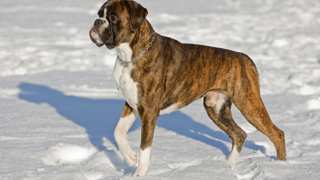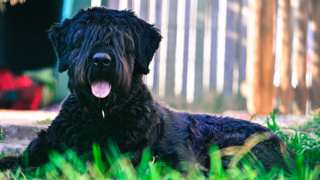With these dogs' medium-length, wiry, weather-resistant coats, German Wirehaired Pointer grooming is not a very time-consuming process. Dogs of this breed shed lightly year-round (and they completely shed their undercoats each spring), so brushing once a week is fine (except during the spring shedding season, when you'll need to brush 2-3 times per week). GWPs also need baths every 2-3 months. And while they won't need full-blown haircuts, many owners strip their dogs' coats several times per year, and they often trim their GWP's facial furnishings with scissors when needed to keep that hair neat and clean.
Brushing a GWP is a relatively simple task. You'll need a medium-toothed comb, and an undercoat rake for removing dead hairs. Start by wetting the coat with mist from a spray bottle, then go through the coat section by section with the comb, in the direction of hair growth. (Don't forget the legs!) Finish by combing through the facial furnishings. Once a month, use the rake in the same method you use to comb, to remove any dead hairs from the undercoat. (During shedding season, you'll want to comb the GWP 2-3 times per week; use the rake once a week during this period to aid the shedding process.)
If you're following the combing with a bath, use either a bathtub or an outdoor kiddie pool and a garden hose. Use canine shampoo (available at pet stores); using conditioner on a GWP is not recommended, as doing so can ruin the coat's wiry texture. Make sure the shampoo is completely rinsed, towel-dry, then give the dog another quick comb-through to neaten the coat.
Stripping a GWP's coat, which should occur every 3-4 months, can be done by hand (whereby the loose, dead hairs are plucked with your fingers) or with a stripping knife. Additionally, a GWP's facial hair can get dirty with food when the dog eats, so many owners choose to trim the facial furnishings with scissors occasionally to keep this from happening. Stripping and trimming can easily can easily be done at home, but it might be good to have a professional groomer do it at least once; the groomer can also provide tips on how to groom a German Wirehaired Pointer in general.








